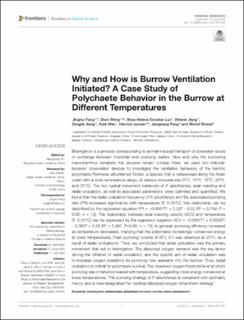| dc.description.abstract | Bioirrigation is a process corresponding to animal-induced transport of porewater solute or exchange between interstitial and overlying waters. How and why the burrowing macrobenthos complete this process remain unclear. Here, we used two infaunal-behavior observation devices to investigate the ventilation behaviors of the benthic polychaete Perinereis aibuhitensis Grube, a species that is widespread along the Asian coast with a wide temperature range, at various temperatures (5°C, 10°C, 15°C, 20°C, and 25°C). The two typical movement behaviors of P. aibuhitensis, axial crawling and radial undulation, as well as associated parameters, were delimited and quantified. We found that the radial undulation frequency of P. aibuhitensis and the associated pumping rate (PR) increased significantly with temperature (T, 5-25°C); this relationship can be described by the regression equation PR = −0.0067T2 + 0.29T - 0.52 (R2 = 0.749, P < 0.05; n = 15). The relationship between axial crawling velocity (ACV) and temperature (T, 5-25°C) can be expressed by the regression equation ACV = -0.0001T3 + 0.0059T2 - 0.063T + 0.28 (R2 = 0.997, P<0.05; n = 15). In general, pumping efficiency increased as temperature decreased, implying that the polychaete increasingly conserved energy at lower temperatures. Peak pumping volume (4.36 L d-1) was observed at 25°C, as a result of radial undulations. Thus, we concluded that radial undulation was the primary movement that led to bioirrigation. The dissolved oxygen demand was the key factor driving the initiation of radial undulation, and the specific aim of radial undulation was to increase oxygen availability by pumping new seawater into the burrow. Thus, radial undulation is critical for polychaete survival. The dissolved oxygen threshold level at which pumping was initiated increased with temperature, suggesting more energy conserved at lower temperatures. This pumping strategy of P. aibuhitensis is consistent with optimality theory, and is here designated the “optimal dissolved oxygen obtainment strategy”. | en_US |
